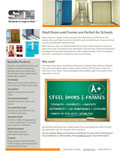Why Architects are Choosing Steel School Doors
Take a look at a nearby school and you’ll most likely see steel doors on the exterior. But you’d have to venture inside to spot the latest trend: more and more schools are opting for steel doors there too.
Why? Because steel is tough as… well, steel, and can withstand the flurry of abuse that kids unleash on doors every day. The old knock on steel doors was that they looked too industrial. Nowadays manufacturers offer custom finishes, stile & rail designs, embossments, and even elegant woodgrain stains to make them attractive.
Why Steel School Doors?
Few doors are more prone to more abuse than school doors. Kids throw their backpacks against them, bang on them, kick the doors open and slam them shut. Teachers and maintenance staff roll carts into doors and wedge them open with chair legs or broom handles. Steel provides superior resistance to this relentless abuse because it is naturally strong and durable.
Steel’s inherent strengths make it the perfect material for school doors.
- weather resistance
- dent resistance
- easy to remove graffiti from properly finished door
- extremely hard to pry open when paired with appropriate hardware
- low cost of maintenance
Placing wood doors in such a high use, high abuse area is wasteful. Much of the splinters and cracks that wood doors are so susceptible to are irreparable. When wood doors are repaired, it’s often a laborious and expensive task. The same applies to aluminum doors. When they are repairable, they usually have to be removed and sent to a workshop. However, aluminum doors are often irreparable too because they cannot be reannodized.
Steel doors are less likely to need repairs in the first place because they don’t crack. Most damage that does occur can easily be addressed in the field by applying a filler material and some fresh paint. Graffiti can often be easily removed from steel doors too.
Specialty Doors
Schools can also benefit from many of the specialty steel doors that are available.
IBC 2015 mandates that new construction of schools in areas susceptible to tornadoes—specifically those located in the 250mph wind speed zone—have storm shelters. Tornado resistant door assemblies required on these storm shelters must pass the testing requirements of ICC 500 and be provided with a certified label of compliance.
Many schools in the eastern U.S. but outside of ‘Tornado Alley’ already specify hurricane-resistant door assemblies to increase safety and minimize the risk of property damage. Many more will soon follow.
With the abundance of steel specialty products available, the possibilities are endless:
- Noise-reducing acoustic doors are ideal for classrooms, music rooms and quiet rooms.
- Steel fire doors are rated up to three hours, offering more protection than other door materials. They are often lighter than fire-rated wood doors too, and do not require through bolting the hinges or door closers—a common requirement for heavy fire rated wood doors.
- Wood-grained finished doors provide the durability and ease of maintenance of steel, with the appearance of wood.
- Hurricane-resistant assemblies have a variety of glass light, louver and other options, while meeting hurricane resistant building codes.
Custom doors and frames allow unique design elements with the durability of steel.
- Stainless steel doors and frames are often used when a high-end appearance is desired or when rust or corrosion is a concern in areas such as cafeterias, pools or wash rooms.
Choosing The Right Doors
In these times of ever-tightening budgets, the biggest driver of schools’ opting for steel is its longevity. Design professionals and school facility managers should keep strength, durability and safety in mind when choosing doors. For example, a Florida county has the following requirements for the doors in their schools:
- windstorm-resistant exterior doors
- steel-stiffened core
- seamless edge
- compliance with ANSI A250.4 Level ‘A’ criteria and tested to 1,000,000 operating cycles and 23 twist tests
Steel also offers extensive LEED credits due to it being 100 percent recyclable.
Bullet Resistant
The threat of gun violence in schools is an unfortunate reality, but one that architects are increasingly addressing when drafting plans for schools. Bullet-resistant steel doors can be an essential element of a school’s security plan when gun violence may be an issue, and there is a wide range of choices defined by Underwriters Laboratory and manufactured by SDI members.
Bullet-resistant doors are manufactured at eight different levels specified by the Underwriters Laboratory. Doors are generally tested in accordance with UL 752 and assigned a level from 1-10 that defines how resistant the door is to gunfire. Steel doors are typically available up to level 8. Each level indicates the number of shots and a particular caliber of bullet that a door can resist. For example, a level 1 door can stop three shots from a 9 mm, while a level 8 (AP) can withstand eight shots from a 30-06 rifle.
Architects work with their school clients to understand the needs in order to avoid overspecification. Increasing bullet resistance increases cost and also may impact installation, such as by increasing the weight or dimensions of a door.
A level 3 door offers plenty of protection for most applications. Some people fall prey to the ‘more is better’ mentality and waste money by overspecifying. Save money by choosing a more reasonable level of resistance. A level 8 door could easily cost eight times more than a level 1 bullet-resistant steel door.
SDI members manufacture to established national and international standards, including the UL specifications for bullet resistant doors.
Work With A Security Consultant
Even the most seasoned professionals benefit from working with security consultants. They are familiar with the codes, trends, and products that will help specify the appropriate door for the schools’ needs.
Security consultants can offer guidance to help ensure that the entire plan makes sense. For example, a school recently being constructed requested bullet resistant doors and frames for a drywall application. Having a bullet resistant assembly in drywall can create a false sense of security and waste the school’s money. Security consultants are experts at helping people avoid these kinds of mistakes.
Access Granted
Between the hustle and bustle of school activities and staff turnover, mechanical keys are sometimes lost by faculty, posing a security risk. Steel doors are compatible with a variety of electronic access control hardware that is more secure and convenient than standard keys. The majority of electronic hardware is activated by codes or cards.
- Codes – School staff enter a PIN to unlock certain doors. PINs can conveniently be created or disabled at any time.
- Cards – Many schools require staff to carry around ID cards. Other than for identification, staff scan their cards to gain entry to locked rooms. Similar to PINs, ID cards can easily be activated and deactivated as necessary.
Retrofitting steel doors for electronic hardware is much easier than it is for wood doors. Steel lends itself to modifications; it can be punched or drilled and then filled and painted.
Appearance Matters
Aesthetics are undeniably an important factor when selecting doors. Some design professionals are under the false impression that all steel doors are plain. Fortunately, that isn’t the case. They can be shaped, painted, or finished to add an attractive design element to any classroom.
Steel doors can be manufactured with vision lites of any size or shape, or with a stylish stile and rail design. They can also be custom painted to match any interior theme.
Specify Steel
Many industry professionals have learned over the years that the strength and durability of steel makes it a perfect fit for school doors. Next time you’re inside a school, check to see if the doors are made of steel. If they are, the architect or specifier was probably an “A” student!

